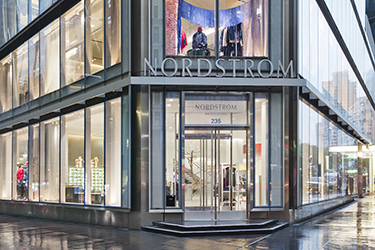|
Subscribe / Renew |
|
|
Contact Us |
|
| ► Subscribe to our Free Weekly Newsletter | |
| home | Welcome, sign in or click here to subscribe. | login |
Architecture & Engineering
| |
April 21, 2020
After COVID-19, what will retailers need to do to win back nervous shoppers?
Journal Staff Reporter
The “butt brush” has been a rule of thumb in retail: Leave enough room so customers' derrieres don't touch and the patrons don't brush up against the merchandise.
That was pre-COVID-19, said Joan Insel, a vice president at CallisonRTKL.
Expect changes, she said. We may see one-way aisles in grocery stores (Kroger is testing that) and retail store design in general changing to give customers more space to shop and do social distancing. Also retailers such as Apple may find customers afraid to go into crowded stores and touch gadgets that have been handled by others.
Welcome to the not-so-brave new world of retail in the U.S.
“It's going to be interesting to see how stores open up and how they deal with the social distancing because people are going to be more tentative,” said Insel, a brand strategist specializing in retail.
The pandemic has made consumers more comfortable using technology as they stay and work at home and buy goods online, said MJ Munsell, chief creative officer at Seattle-based MG2.
For example, between Feb. 24 and March 21, buy-online, pick-up-in-store orders increased by 62% compared with the same period a year earlier, said Munsell, citing Adobe Analytics.
“Tech has and will have more of big impact,” she said.


Munsell, who has led retail teams for over 30 years and now works with all of MG2's markets, said retailers must up their tech game so customers can buy any way they want, whether via apps, store websites, social media platforms, curbside, in-store or online inside stores. Those who don't will be left in the aisle.
Better inventory management for efficiency and to lessen the chance of getting stuck holding the bag in another black swan event is going to be key, she said.
Expect lots of items to go on sale, at least initially, said Munsell, as retailers may have to steeply discount merchandise because new inventory is coming in.
“They're going to be forced to merge seasons pretty quickly when they open the doors,” said Munsell, noting some are already dropping prices online.
Store designers may need to create engaging ways to promote the older merchandise, such as pop-up spaces and events, without putting the entire store on sale, she said.
Munsell said that, according to the U.S. Department of Commerce, retail sales nationally dropped 8.7% and online sales advanced 3.1% in the first quarter compared to that period last year. Fitch Ratings suggests that retail sales could decline up to 50% in the first half of 2020, she said.
SHOPPING ONLINE
Insel expects an uptick in orders from online subscription services, such as Stitch Fix and Nordstrom Trunk Club, where you put in your profile, talk to a stylist and receive clothing based on that. You send back what you don't want and offer feedback. Amazon Prime, she said, is testing a wardrobe subscription service.
People also may gravitate to more personalized shopping to avoid crowds, she said. With that, they work with a salesperson to pick outfits online, make an appointment, and try on the clothes in the store but away from other shoppers. A retailer can track how close a customer is to its store by cellphone GPS and meet them at a particular entry using a digital photo if they allow that.
Anyone can use the personal shopping service of Nordstrom, a CallisonRTKL client, said Insel. “They make you feel like a VIP even if you don't have the VIP cash,” she said.
Before the pandemic, some brick-and-mortar stores had already been trying different formats, such as becoming more like showrooms, with much of the sales online, she said.
“This is just going to push it to the next level,” she said, perhaps with fewer items in stores or no inventory, or less inventory stored in the back.
The SARS outbreak of the early 2000s, for instance, propelled online sales in China, benefiting the likes of Alibaba and JD.com.
Insel said she thinks stores will look to health care in some ways, with fewer touch screens and more voice or facial recognition, or some other method, for credit card payments. In China, “There's a Kentucky Fried Chicken where you can pay with a smile,” she said.
People are going to be really nervous about touching stuff, she said, “especially for the first few months after this.”
Restaurant staff may wear masks and gloves and offer disposable menus, she said. Hotels, which had been moving to all-white rooms to create a perception of cleanliness, may have to go beyond that. “Everything is going to have to be rethought,” Insel said.
BACK TO BASICS
Post-pandemic will be interesting for the beauty industry, said Munsell, as it is about “testing and playing.” Expect, perhaps, more virtual testing in stores and at home and more small, prepackaged tester products, but customers will still want advice and to see the goods in-store, she said.
Clothing stores may have pre-booked and pre-sanitized fitting rooms, stores with play areas might have touchless ways for children to interact, and more grocery stores may have sneeze guards and shields at checkout, Munsell said.
More people may focus on buying basics, Insel said, and fewer discretionary and luxury goods. New shopping models may become popular, for instance trading in goods you previously purchased, as more people will lack cash.
Some people, because of budget constraints or out of fear of social contact, may continue, as they have during the crisis, to cut and color their hair and do their own nails, Munsell said, but some may celebrate after the pandemic with new clothes and trips to the salon.
The work from home phenomenon has meant looser clothes and less makeup for women, she said.
Anecdotally, Walmart is seeing more sales of tops and less of bottoms, Insel said, and some retailers report women are buying more wireless bras as opposed to underwire.
She and Munsell agree change appears to be in the works for the industry.
The most profound may be this: Some retailers and restaurants will not recover from the pandemic, said Munsell.
Lynn Porter can be
reached by email or by phone
at (206) 622-8272.



